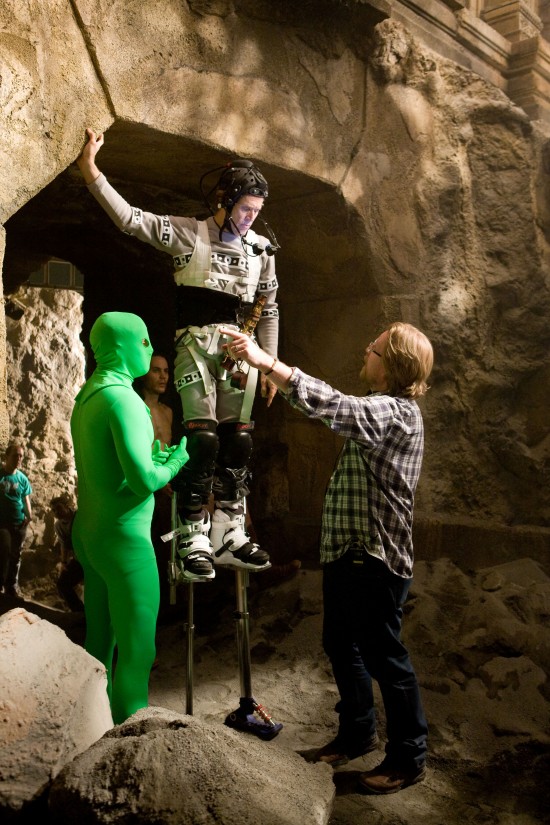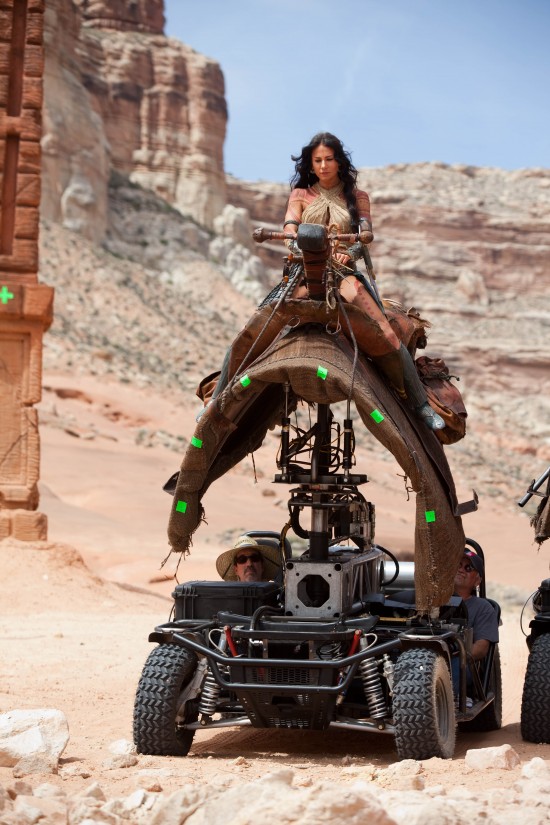/Film Visits The Set Of 'John Carter'
I visited Mars almost two years ago. It was April 2010 and the film set was in the middle of nowhere. Finding Nemo/WALL-E director Andrew Stanton was making his live-action debut John Carter, a big screen adaptation of Edgar Rice Burroughs's novel A Princess of Mars. There had been many failed attempts to bring the material to the big screen, but somehow Stanton was able to convince the studio heads to let him be the one to make the adaptation at a cost of hundreds of millions of dollars.
Disney flew a group of journalists into the Las Vegas airport, where we boarded a shuttle bus to a location five hours away. A location so far away that we were no longer in Nevada. Located at the center of the Grand Circle, Big Water Utah has a population of only 417 people (which probably explains why you didn't see many John Carter set photos). The set was located out in the middle of a desert.
You wouldn't have any idea a big Hollywood production was being shot in town, aside from small yellow signs that read "BARSOOM" which help crew members find the small dirt road which leads to the set. And by set, I mean a few structures which have been constructed on the grey dirt in the middle of these large brown hills made of sandstone. Barsoom, of course, is what the Martians in the books call their home planet.
Producer Colin Wilson tells us that visual effects artists will augment the hills with alien windows and structures. Wilson just got done working a long stint as Executive Producer and Unit Production Manager on James Cameron's Avatar, so he's happy to be out of a performance capture studio and back in a real environment. When the John Carter teaser trailer was released a year and a half after this visit, fans criticized that it looks like Cameron's Avatar. Sure, there are computer animated characters created using performance capture, but the production of the film couldn't be more different.

We watch filming as Willem Dafoe and Thomas Haden Church (both academy award nominated actors, and members of Raimi's Spider-Man villain gallery) walk around on three-foot tall stilts. Men in green suits shadow their legs in case they tumble. The alien creatures in the film are nine to ten feet tall, four-armed, and have large tusks. Dafoe and Church are wearing the grey pajama-looking mocap suits you've seen in DVD/Blu-ray special features for other movies. They're wearing huge head gear with telescoping arm cameras to capture their complete facial movements. While normally you'd think this would be distracting, the actors praised the head rigs for helping them figure out where their large tusks would be in real-space.
Thomas Haden Church told us,
For the most part, our physicality is captured by the cameras and then all of our facial maneuverings and manipulations are caught by the headset cam, There are two of them. It's a different process because, on Spider-Man, so little of it, so little of the animation was available to me as a physical actor, whereas this, you're completely embedded in it. My whole body and my head and everything is going to be in motion capture with an infusion of my body and, as I already said, my physicality and expressions and emotions of it.
The whole set-up helps the lead star Taylor Kitsch interact with these gigantic alien creatures, and gives the performers more control of the animated performance. In the scene we observed, Kitsch is arguing with the alien group — the stilts allow him to get a proper eyeline and see the performance in real time, rather than have to imagine and interact with a performance that doesn't exist.

We were shown a rig which allowed the actors to ride alien creatures called thoats. Basically it is a moving vehicle with a saddle controlled by a puppeteer to simulate the galloping of the animal. They would later add the computer animated creature into the shot. Normally such a sequence would be shot completely on green screens, with the actors sitting on a bouncing rig. Stanton wanted to make Barsoom feel as photo real as he could, and use computer generated effects for the alien creatures and to augment practical locations and constructed sets.
Things change over the years. The movie was still titled John Carter of Mars while we were on set, and didn't get retitled until a year later. Stanton told us that he wasn't interested in releasing the film in 3D and that the studio was behind that decision. Meanwhile, Producer Colin Wilson told us that there were still internal talks about the possibility of post conversion. We all know how that turned out — the film is being released in post-converted 3D.
Behind the scenes photos:
